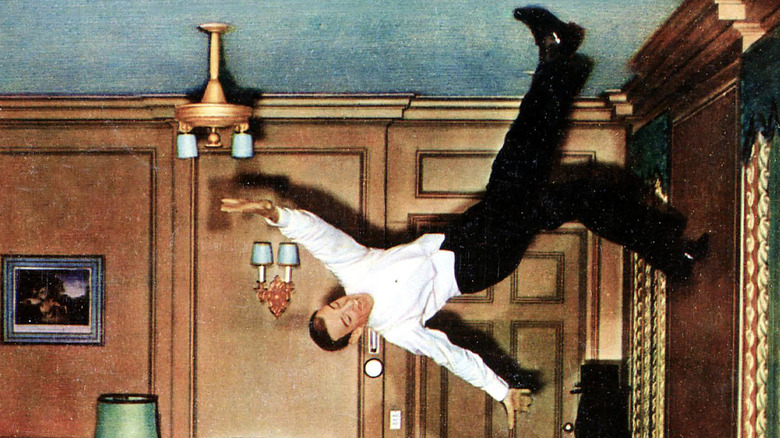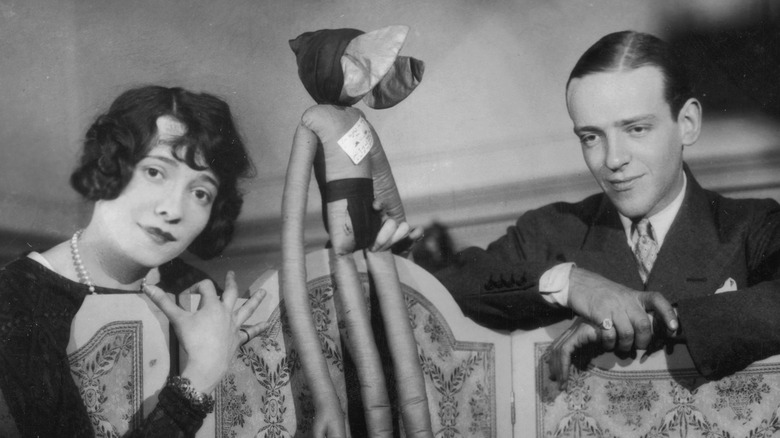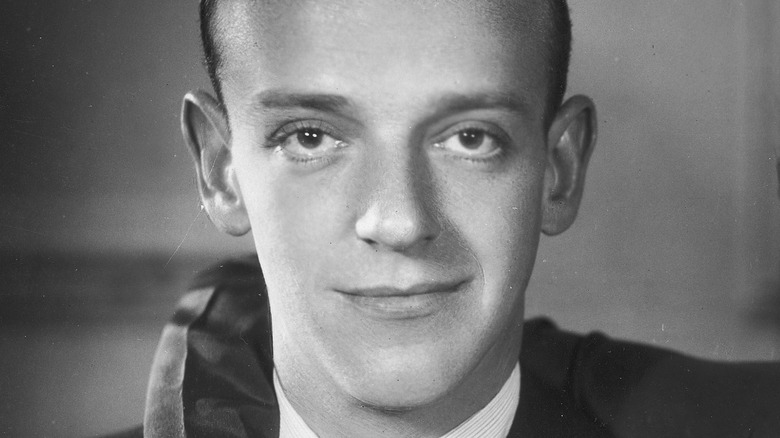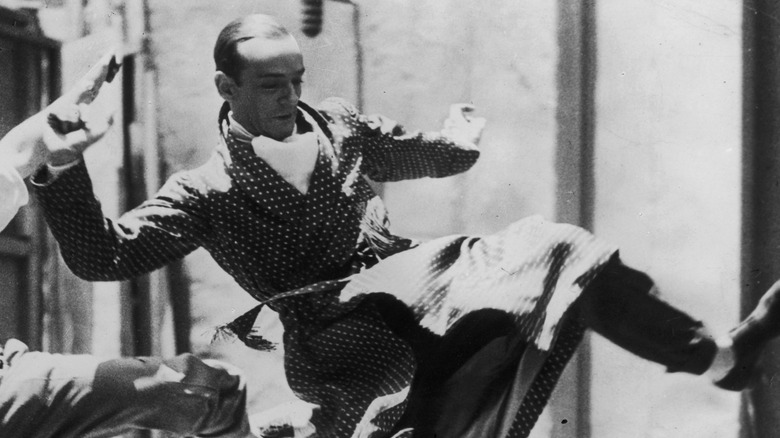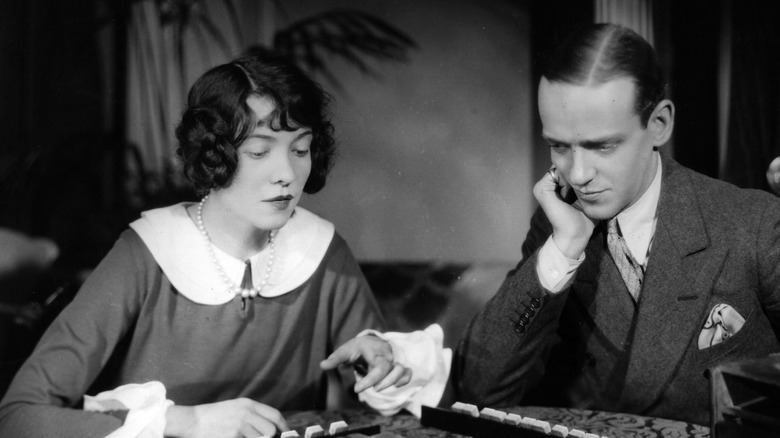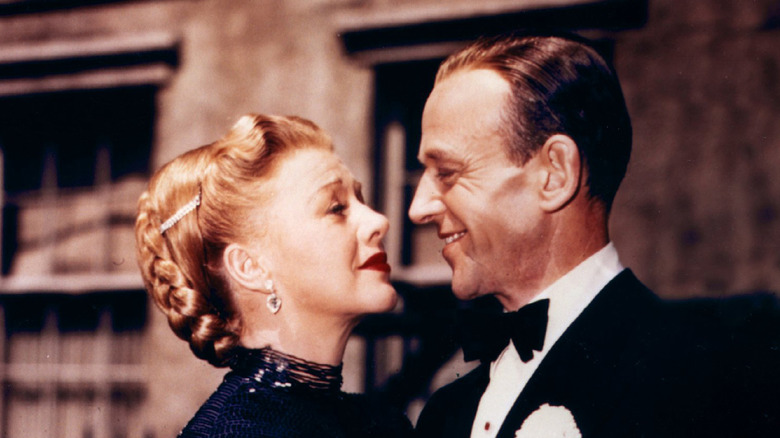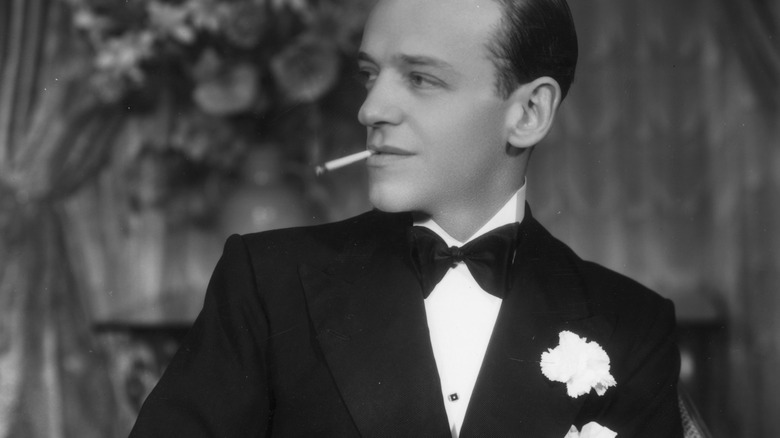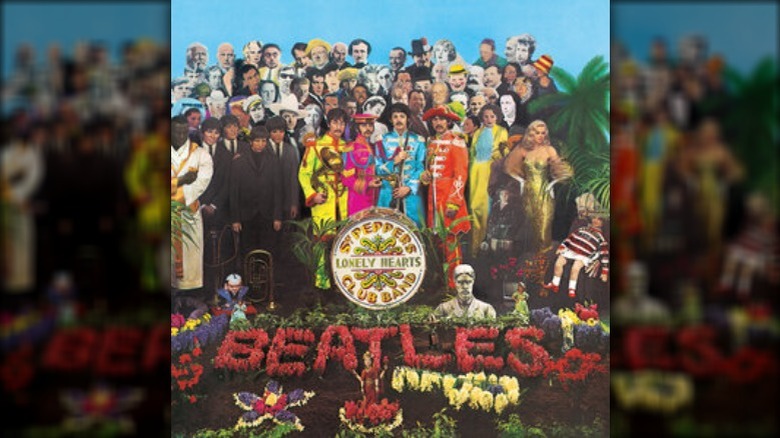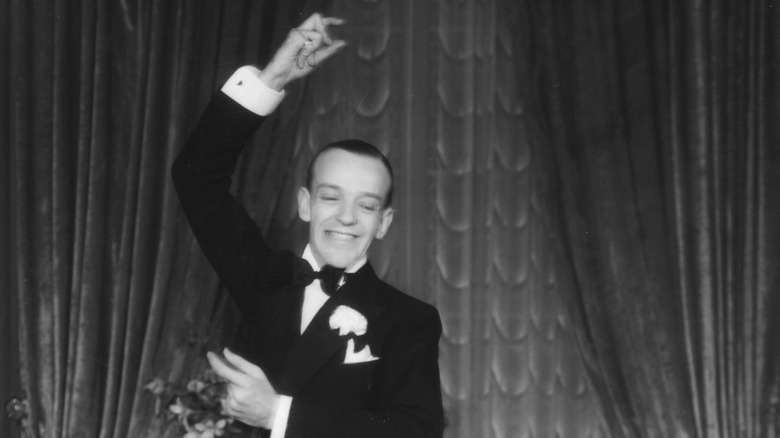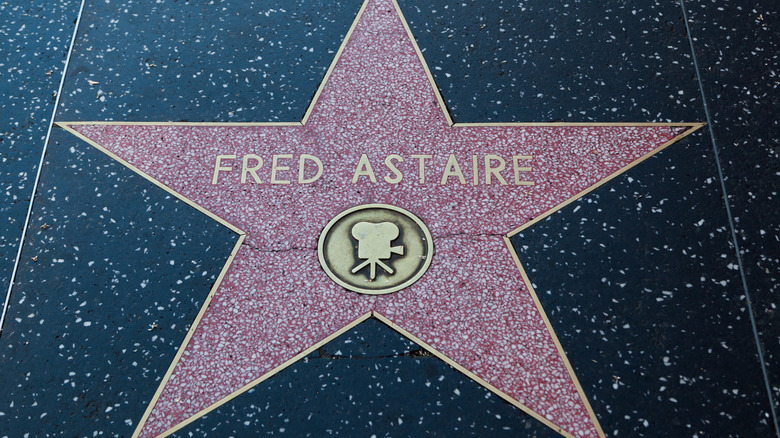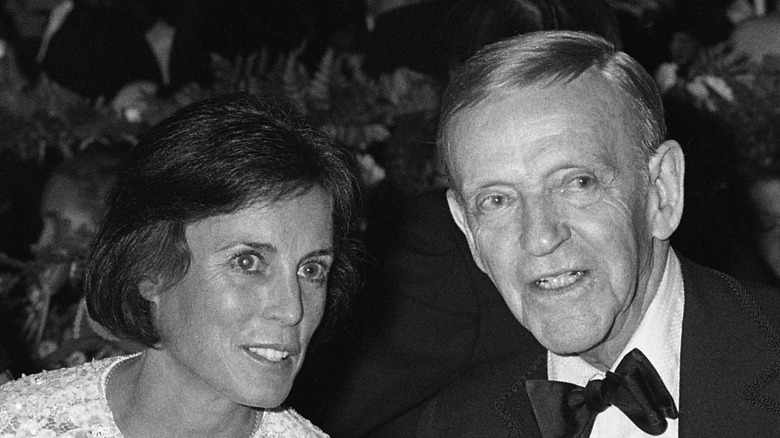The Untold Truth Of Fred Astaire
It's hard to forget a man who dances on the ceiling or with a hat rack, and Fred Astaire is a well known name in many households, young and old. His unique style of dancing — a combination of tap, ballroom style, and ballet, but always with a quirky twist — inspired so many imitators it's hard to count. Famous professionals regularly name him as their biggest inspiration, praising his agility, elegance, incredible speed, and accuracy, along with his pas de deux skills. The widespread influence of TV screens made him "the most widely seen dancer in history," and many dance journalists report that 90% of answers to the question of "why dance?" are Fred Astaire, states Alan M. Kriegsman for The Washington Post (via Reel Classics).
He was dedicated to his dance craft, always looking for new ways to challenge himself. Per Dance Teacher, that included dancing on the walls ("Royal Wedding," 1951), dancing with his own shadows ("Swing Time," 1936), dancing in a roller-skate rink ("Shall We Dance," 1937), and even dancing in a rocking ship (also "Royal Wedding").
Many know him after duets with Ginger Rogers, although their relationship wasn't the closest, and Astaire perceived himself more as a soloist. He had lots of peculiar habits, such as hiding his hands and buying his clothes in London. And not only dancers found inspiration in him, but people like Jackie Chan and Paul McCartney as well. Here is the untold truth of Fred Astaire.
His family got him into entertainment business
As is very common for superstars, Fred Astaire had a career of an entertainer even as a child, performing with his sister. This was encouraged by their mother, who fantasized about leaving Omaha and building a better life. As per the biography "Fred Astaire," the story started with Adele, Fred's sister, who was pretty already as a child, and her dancing lessons. She was the main driver behind all the effort put into the kids' upbringing; Fred just went along with it, mimicking his sister. After the siblings moved to New York with their mother to pursue their stage careers, the only person they knew was a dance teacher: Claude Alvienne, their future choreographer. Slowly, their career progressed.
According to LiveAbout, their first appearance on Broadway took place in the show "Over the Top" in 1917, and their stage careers continued well into 1920s with musicals such as "Lady Be Good" and "Funny Face." But, not making it into movies straightaway, they moved to London, where they lived from 1928 and 1932. There, they did achieve success on the West End, regularly performing for many important people, including the royal family, Lord Charles Cavendish, and Winston Churchill (via Yahoo News).
Adele and Fred's last performance took place in 1932, just before Adele got married to Cavendish and ended her career for good. Fred always regretted losing Adele, and he decided he would dance as a soloist from then on (via LiveAbout).
He failed his first screen test
When the doors of Hollywood opened to a wider set of talents, including dancers and musicians in 1927, Fred and Adele Astaire were ready. After achieving a fair amount of success on Broadway and Britain's West End, they confidently did a screen test for a "Funny Face" movie, but that didn't result in a triumph as they expected. As Clive Barnes reported for Dance Magazine, the producers did not like Adele at all, describing her as "lively." They found Fred unsuitable as well, stating he "Can't act. Can't sing. Balding. Can dance a little."
But, according to "Fred Astaire," the story was never authenticated, and the person who said these scandalous words was a studio operative, not a producer. What was confirmed was that David O. Selznick, the head of RKO studio, later an executive for MGM, saw potential in Fred, describing him as "one of the great artists of the day" in a letter to RKO assistants in 1933. He did mention his big ears and a weak chin line, but still thought that his charm came through even in the infamous screening test. Soon after, MGM and Astaire signed a contract for $1,500 per week, lasting three weeks.
He redefined how dance movies were made
Fred Astaire was a perfectionist, always striving towards excellence. For him, it wasn't just important to nail the choreography and perfect the rhythm, but to look good on camera as well.
According to Fred Astaire Dance Studios, he insisted that film dance scenes must resemble a stage performance, meaning the dancer was fully framed in the shot with as little interruptions from the camera as possible. He wasn't keen on close ups at all, arguing for a wider angle which showed every part of the dancer's body. Quick transitions between shots and lots of cuts drove him crazy because they interfered with the fluidity of movement.
As Anna Kisselgoff from The New York Times observes, the films he made more closely resembled theater pieces — "dance films with plots," so to speak — than a regular movie which includes dance numbers. It didn't really matter whether you saw him on stage or in a film, the effect on the viewer was the same. By this, he invented a rare and completely new art form: the "film dance."
Fred Astaire was not his real name
While Fred Astaire and his sister were born in USA, their father wasn't, as explained in "Fred Astaire." Frederic Fritz Austerlitz was born in Linz, Austria, but soon decided to leave the country for a better life in the USA. Arriving to Omaha, Nebraska, Frederic soon met Johanna Geilus, a schoolteacher working in a German Lutheran immigrant community (via "Puttin' on the Ritz"), with whom he had Adele Austerlitz and Frederick Austerlitz, known as Fred.
The family — sans the father, Frederic, who stayed back home in Nebraska in order to provide a steady income — moved to New York to pursue the dance career of the two children. It was the dance teacher Claude Alvienne who suggested that the surname Austerlitz sounds too German, and they should change it to Astaire. Mother Johanna Austerlitz soon became Anna Astaire, and, of course, there was the sibling entertainment duo: Adele and Fred Astaire.
He didn't want to dance with Ginger Rogers
Fred Astaire's first reaction to the idea of pairing up with Ginger Rogers was very telling. After his sister Adele left the business, he wrote to agent Leland Howard in 1934: "What's all this talk about me being teamed with Ginger Rogers? I will not have it, Leland — I did not go into pictures to be teamed with her or anyone else, and if that is the program in mind for me, I will not stand for it" (via "Fred Astaire").
As further explained in "Fred Astaire," neither of them wanted to succeed as a part of a couple — Astaire wanted a solo career, and Rogers wanted to be perceived more as an actress than a dancer. Their relationship was tense, starting off as a fling before they ever worked together, and Rogers wrote in her own biography that if she stayed in New York at the time, they could become a serious item.
But that never happened, and they had to deal with each other professionally from then on, which wasn't easy. Astaire was a perfectionist and took the concept of practice to a completely different level — even to the point where Rogers couldn't take on new projects, since she spent so much time practicing dance numbers with Astaire. He interfered with her performance clothes, losing his mind over feathers that got in his mouth or bell-shaped sleeves which hit his face during spins. She resented him for his massive success and felt she should deserve more praise for her work.
He loved London tailoring studios
Astaire always paid attention to his clothes, as said in "Fred Astaire," but his style became even more notable during his days in London. He started to follow fashion more closely, aspiring to look like members of the British upper class. He often visited Savile Row and its tailoring studios; his favorite was Anderson & Sheppard, which was well known among the members of the royal family as well.
As Lady Alexandra Metcalfe told biographer Sarah Giles in "Fred Astaire: His Friends Talk," Astaire greatly admired the style of Prince Charles, Prince of Wales, and his love of waistcoats. When the information got out that the Prince of Wales dressed himself at Hawes & Curtis studio, Astaire was there in no time. He also loved crisp shirts created by Beale and Inman.
According to Victoria & Albert Museum in London, Astaire often used his own suits in movies. When he tried out the suits, he always performed some dance steps, to confirm that the suit was suitable for dancing, and the tailoring stayed perfect even while moving around. The suits had to be made in a special way, to allow more flexibility.
He was close with the Beatles
Fred Astaire crossed paths with the famous band on several occasions throughout his life. When the group was selecting the celebrities who were portrayed on their legendary "Sgt. Pepper's Lonely Hearts Club Band" cover in 1967, they thought of dancing icon Astaire. The idea was to use paper cut outs of a crowd of famous people, who would surround the band, photographed by Michael Cooper. As per uDiscoverMusic.com, Astaire was excited to participate.
Soon after, as Ray Connolly describes for The St. Regis Magazine, John Lennon and Fred Astaire met in summer of 1971, when Lennon and Yoko Ono moved to New York. Neighbors at the famous St. Regis hotel in Manhattan, Astaire knocked on Lennon's door and greeted the musician. Soon, they were working on Ono and Lennon's autobiographical movie, "Imagine," with Astaire agreeing to play a small part — he played himself.
When Paul McCartney published an album of his American classical songs, he mentioned his admiration for Fred Astaire. As McCartney told Laurence Juber in the One Track Mind podcast, he always wanted jackets as Astaire had, smooth and straight. But more than his dressing style, he loved Astaire's singing approach, and he tried to imitate it when they recorded "Sgt. Pepper's Lonely Hearts Club Band" (via Something Else! Reviews).
He curled his fingers while dancing to hide his big hands
Although Fred Astaire was quite small and very slender, his hands were unusually big. As described in "Fred Astaire," his thinness was usually hidden under suits and jackets, always on the verge of revealing how small-scaled Astaire actually was. But the hands — that was another story: compact palms with bulky fingers, like the hands of a physical worker. The disproportionately lengthy thumb didn't fit the rest of the hand, and the overall look was drastically different from the elegant hands of ballet dancers: "My hands are huge, look at them. In ballet you need to hold your hands so gracefully, and my hands are so big that I would look ridiculous," he complained to Leslie Caron, a fellow dancer.
To cover this imperfection, he learnt how to hide his hands in photo shoots as well as when dancing. The latter was trickier, since he used the whole body while dancing, including his hands, but he still managed to find a solution. He shortened and narrowed the hand by bending his middle finger, whilst covering the fourth finger with it, which made hands look smaller. He did pay special attention to hand gestures specifically, rehearsing even minor actions, such as putting his hand in a pocket.
He inspired how Jackie Chan choreographed his movies
It's no secret that dance choreographies resemble the intricate pattern of martial arts techniques. Jackie Chan, the legend of on-screen Kung-Fu fighting, knew where to look for inspiration. Fred Astaire is one of his heroes, as he told Don Kaplan for New York Post, among Charlie Chaplin, Gene Kelly and others: "The silent veterans amaze me with what they were willing to do in an era where special effects were unknown! They really did all the stunts themselves. Kelly and Astaire on the other hand impressed me with their timing and rhythm. They influenced me a great deal in my action choreography, especially in the use of impromptu on-the-set articles and objects."
According to Anna Green for Mental Floss, critics often correlate Chan's movie performances with the ones of the famous dancers, and Chan confirmed this on many occasions, claiming he "totally copied from Gene Kelly and Fred Astaire." But it wasn't just choreography; Chan learnt a great deal about framing and filming movement from Astaire's dance films. He builds his fighting scenes with a scene of Astaire dancing with a chair in his mind, along with looking up to his impeccable timing when it came to comic sequences.
Other dancers 'hated' him
When Mikhail Baryshnikov presented the American Film Institute's Life Achievement Award in 1981, he revealed the truth about how others perceive Astaire: "It's no secret. We hate him. He gives us complexes, because he's too perfect." He continued by describing how hard it is to compete with Astaire, whose excellence is always present on screens.
Baryshnikov wasn't the only dance icon who publicly praised Astaire for his brilliance, reports Alan M. Kriegsman for the Washington Post (via Reel Classics). Astaire inspired generations and generations of dancers. Margot Fonteyn adored the ease of Astaire's dancing, which seemed "more natural than breathing." George Balanchine told John Mueller how rare a talent like this is: "He is like Bach, who in his time had a great concentration of ability, essence, knowledge, a spread of music. Astaire has that same concentration of genius; there is so much of the dance in him that it has been distilled." Balanchine also named Astaire as his biggest influence, same as Jerome Robbins, who included footage of Astaire and Rita Hayworth in his ballet "I'm Old-Fashioned" in 1983. Even Rudolf Nureyev himself admired Astaire, performing a tap piece in homage to Astaire in "The Muppet Show." Merce Cunningham told Alicia Zuckerman for New York Magazine that it was Astaire's movies which inspired him to first take dance lessons.
When Cunningham presented Astaire with the Capezio Award in 1987, he commended the unique character he had while dancing: "The sheer pleasure of his dancing — a quality that makes us lose track of mental gymnastics. It gives the mind a rest and the spirit a big boost" (via The New York Times).
He died of pneumonia
Fred Astaire was fit and active in later life as well, never giving up on his love of movement. He loved skateboarding, a hobby he started when he was more than 70 years old, and of course never stopped dancing (via The Vintage News).
He got married for the second time as well, after spending 26 years as a widower, losing his first wife to cancer. He married Robyn Smith, a 35-year-old professional jockey, in 1980. Astaire died exactly seven years later, revealed Smith to Charles Champlin for Los Angeles Times: "We'd had seven years of bliss. It was fate, absolutely; I know God put us together." At 88, Astaire's life ended due to pneumonia, which happened unexpectedly but didn't last long, according to Smith: "I think his life just ran its course. It's devastating to see someone you love fade away but thank God he didn't suffer." Burial ceremonies took place in a private circle, and his will remained secret from the public, although Smith did state he didn't wish to receive any additional acclaims posthumously. She took over his matters after he died, fighting against anyone who would want to unlawfully capitalize on Astaire's name or creative opus: "I'm just trying to protect my husband. What he wanted, what he didn't want. I'll do everything I can to carry out his wishes. I hope it doesn't make me look bad or seem like a power trip. But if it does, so be it."
